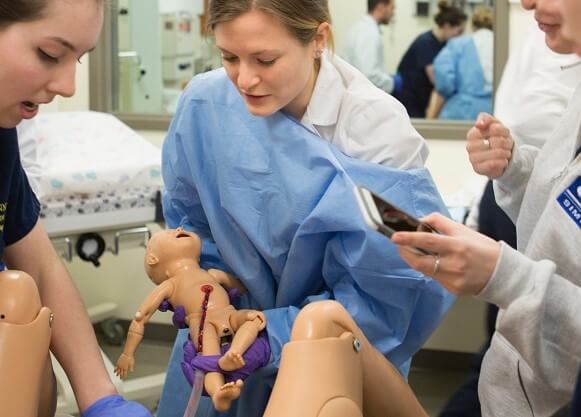
Students come together for simulated birthing experience
March 09, 2017

March 09, 2017

A frantic text was sent: “!!! STAT rapid response team to the SIM L+D STAT !!!”
By the time a pair of first-year physician assistant students rushed and scrubbed in to the labor and delivery simulation lab, a handful of junior nursing students were comforting a young woman named Alyssa, taking her vitals and prepping her for one of the most physically and emotionally draining experiences a woman can face.
Seven big pushes later, a 21-inch long, 5-pound, 8-ounce baby girl let out a reassuring scream as she was placed on a nearby warming table.
The birth was staged as part of an innovative interprofessional learning experience to prepare students from across health care-focused disciplines to learn to think quickly, work collaboratively and better understand each other’s roles in different health care situations.
Although the two physician assistant students knew a birth was imminent, they did not know exactly when it would happen and were on call. When the text came in, they rushed out of class and to the School of Nursing simulation lab.
“One of the key objectives here is to work on interprofessional communication and teamwork,” said Liana Kappus, simulation director at our School of Nursing.
“How are nurses giving a handoff to the PAs, and how are they closing the loop on communication and supporting each other?”
The simulation experience corresponds with student coursework — and the nursing students’ newly designed on-campus, clinical maternity rotation. The students had never worked with each other before.
“Often in health care, clinicians are learning in silos; nursing students typically learn and practice with other nursing students, and providers are role-played by faculty — and the same with the physician assistant students,” Kappus said. “There is a big push for this same type of interprofessional teamwork training in the hospital setting. We are fortunate to be able to offer our students this opportunity to practice together in a safe environment to increase their confidence and prepare them for their work in an actual clinical setting.”
Although they are not simulating deaths or fatal mistakes in this module, the technology does allow it — and could be used later.
“We want to introduce the students to what it is like to be part of a team and better understand where their priorities need to be, where they overlap with each other, and where they operate independently,” said Dennis Brown, clinical assistant professor of physician assistant studies. “Other than being in the health care facilities, you are not going to find that in any other classroom. You need these types of opportunities where we tell them to go and then debrief them afterward and share our learning moments.”
After each simulation, the nursing and physician assistant students debriefed together, discussing what they did well and what they could improve upon — such as when sterile gloves need to be used rather than regular latex gloves and also how one could take a fetal pulse if the monitor failed.
“It’s the reality of what may happen,” Brown said. “It’s a safe, controlled learning environment — and as close as you will get to simulating what goes on.”
This semester, 147 nursing juniors and 55 first-year grad PAs are going through the simulation. There are other students who will participate in other rapid response simulations as well.
He said the majority of students nationally have to wait until they enter their residencies and work in hospitals to experience such training.
“From our students’ perspectives, it has been very beneficial,” Brown said. “They learn a lot about each other’s professions, what roles they play and how they can work better as a team.”
Quinnipiac Today is your source for what's happening throughout #BobcatNation. Sign up for our weekly email newsletter to be among the first to know about news, events and members of our Bobcat family who are making a positive difference in our world.
Sign Up Now